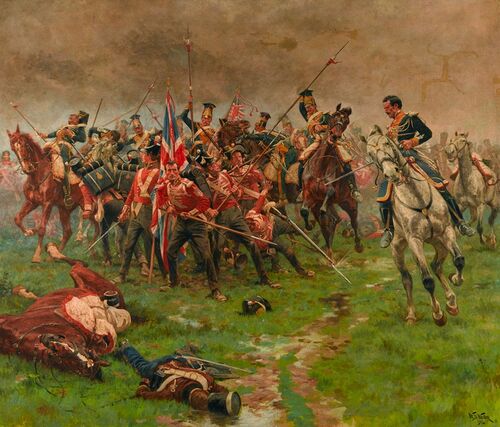Auction: 24002 - Orders, Decorations and Medals
Lot: 35
Military General Service 1793-1814, 8 clasps, Talavera, Busaco, Albuhera, Vittoria, Pyrenees, Nive, Orthes, Toulouse (James Rapkins, 66th Foot), edge bruising, very fine
Unique clasp combination, Rapkins is the sole member of his Regiment entitled to this clasp number and combination.
Provenance:
Glendining's, 1926 & 1952.
James Rapkins was born in 1787 in East Meon, Hampshire and enlisted with the 66th Foot in 1806 as a volunteer from the Army of Reserve. They disembarked at Belem in April 1809 and formed part of General Hill's Brigade, Rapkins was in the 10th Company and quickly saw action at the Battle of the Douro, where the unit crossed the Douro River in barges and fought the French at the walled seminary. They next fought at Talavera in July 1809 as part of General Tilson's Brigade in Hill's 2nd Division, fighting to the left of Wellesley's line. Rapkins joined the count of 99 members of his Regiment wounded during the battle on 28 July when he suffered a severe wound to his right knee, transportation to General Hospital took twelve days and he remained there recovering for another 79 days.
They were present for the Battle of Busaco in September 1810 but saw little action. The unit formed part of Lieutenant-Colonel Colborne's Brigade in the bloodiest battle of the war, Albuera, on 16 May 1811 where they countered the French main attack on General Beresford's right flank and made a costly yet effective charge on French Major-General Girard's columns. A heavy rainstorm struck, and under cover of the storm General Latour-Maubourg launched a devastating charge on the right flank in which the Polish 1st Vistula Lancers and French 2nd Hussars practically annihilated Colborne's Brigade, the 66th Foot sustained a 62% casualty rate. They were included in the First Provisional Battalion, formed by Lieutenant-General Arthur Wellesley from the remaining regiments in the wake of the heavy losses faced at the Battle of Albuera.
They fought at the Battle of Vittoria as part of Major-General Byng's Brigade in Hill's 2nd Division, in which they remained for the Battle of the Pyrenees on 25 July 1813. Byng's Brigade was positioned at Roncesvalles and held off Clausel's advance for hours before finally falling back to Altobiscar, regrouping two days later at Sorauren and helping to defeat the French and successfully push them out of Spain. The Regiment was present for the Battle of the Nive in December 1813 when, on the 13th, General Soult led a counterattack on Hill. The unit suffered 73 men killed and wounded. At the Battle of Orthes, Hill's 2nd Division entered the battle late in the day when the French were in full retreat, thus suffering no casualties. Soult was finally defeated at the Battle of Toulouse in April 1814, though the First Provisional Battalion was not engaged in much fighting and they disembarked for Cork shortly afterwards.
Rapkins also had the distinction of guarding the exiled Emperor Napoleon on the remote isle of St. Helena, to which he arrived with his Regiment in May 1816. Whilst on St. Helena, the 2/66th Foot was later disbanded and absorbed by the 1/66th Foot. They left for England following Napoleon's death on 5 May 1821 and Rapkins was in the final detachment to arrive. Back home, Rapkins was discharged in 1823 due to the wound in his right knee from Talavera, as well as a chronic rheumatic affection of his hip which developed while on St. Helena. Census records show that Rapkins married Elizabeth Tribe and lived the rest of his life in Eltham, Kent with his wife and children where he died as a Chelsea pensioner on 31 March 1865; sold together with copied research.
Subject to 20% VAT on Buyer’s Premium. For more information please view Terms and Conditions for Buyers.
Sold for
£3,500
Starting price
£1400







